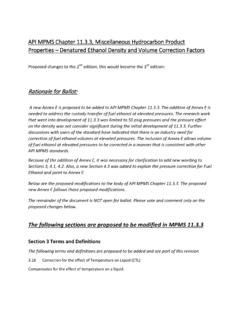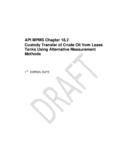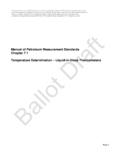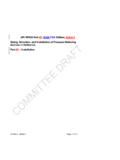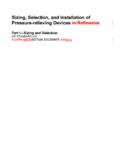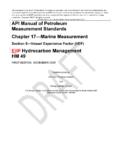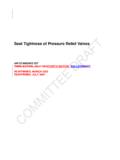Transcription of Addendum 2 to API MPMS Ch. 11.1-2004— Temperature and ...
1 Addendum 2 to API MPMS Ch.. Temperature and Pressure Volume correction factors for Generalized Crude Oils, Refined Products, and Lubricating Oils Note: Added text is highlighted. Deleted text is indicated by strikethrough. Changes to Previous Standards The term compressibility coefficient and symbol F p are used in other standards in a different way. The term and symbol were changed to scaled compressibility factor and F s , respectively, to distinguish the difference. Section was updated to reference API MPMS Chapter for density and volume corrections of gasohol blends. Sections were added for guidance on volume corrections for ethanol, vacuum gas oil (VGO), and naptha. Clarification was added to the use of the terms standard, observed, and alternate conditions. Clarification was added, and examples were updated, to show final density and volume results should be calculated with unrounded C TL and C PL values or an unrounded C TPL value.
2 Wording was added to indicate the examples are provided to guide users in developing computer implementations of the Standard, but are not part of the Standard. If other standards call for use of a C TL factor, alone. An equivalent C TPL factor may be calculated by using a gauge pressure of zero. Steps in Sections and were updated to use an arbitrary input density as required in the implementation procedures. Section was added to Appendix C to guide users in converting thermal expansion coefficients to Temperature units other and F-1. Appendix F was added to show how the equilibrium vapor pressure of liquids affects the calculations. Scope As this Standard will be applied to a variety of applications the output parameters specified in this Standard ( , 60 , T , CTL, F p F s , CPL, and CTPL) may be used as specified in other API Manual of Petroleum Measurement Standards (MPMS) Chapters. This Standard provides general procedures for the conversion of input data to generate , 60 , T , CTL, F p F s , CPL, and CTPL values at the user specified base Temperature and pressure (T b , P b ).
3 LPG and NGL. LPGs (Liquefied Petroleum Gases) and NGLs (Natural Gas Liquids) are predominantly butane and propane separated from natural gasoline or natural gas or produced during refinery processing. Most LPGs and NGLs are less dense than the liquids covered by this Standard. API MPMS Chapter 8217 Temperature correction for the Volume of NGL and LPG Tables 23E, 24E, 53E, 54E, 59E, 60E Gas Processors Association (GPA) Technical Publication TP- 25 Temperature correction For The Volume Of Light Hydrocarbons (or its successor) should be used for the Temperature portion of the volume correction factors for liquids with 60 /60 . relative densities of to ( to API at 60 F, or to kg/m3 at 60 F). The tables in this Standard generally apply to products that do not have to be stored in pressurized containers at normal temperatures. GasoholBlends of Gasoline and Ethanol Gasohol is a mixture of gasoline and 10 vol% ethanol.
4 Based on data (available at API) obtained at the University of Missouri Rolla, gasohol is best represented as a special application with a 60 F thermal expansion factor ( ). of 10-6 F-1. There are several defined blend ranges within fuel specifications which are frequently referred to by the upper limit of the volume percent of ethanol in the blend. For example, E10 refers to a blend which contains up to 10. volume percent of ethanol. Research by the API has shown that when the gasoline blendstock (often referred to as a blendstock for oxygenate blending, BOB) and ethanol are blended there is an increase in the total volume and the coefficient of thermal expansion. Based upon this research, API developed methodologies which are summarized in API MPMS Chapter to cover density and volume correction factors for blends of denatured ethanol and gasoline blend components ranging from 0 % up to 95 % denatured ethanol.
5 Refer to API MPMS. Chapter for volume correction of gasoline and ethanol blends. Ethanol Refer to API MPMS Chapter for volume correction of fuel grade ethanol. Vacuum Gas Oil (VGO). Vacuum gas oil is a distillation product of crude oil generally with a boiling range between 310 C to 600 C. This group of materials was included in the data base for Fuel Oils group of the products tables and was best represented by the products tables. Naphtha Naphtha is a general term for flammable hydrocarbon mixtures. In the refining industry, petroleum naphtha typically has a boiling range between 35 C and 205 C and consists of hydrocarbons containing between 4 and 11. carbon atoms. Virgin naphtha was included in the data base for the Gasolines group of the product tables and was best represented by the products tables. Heavy naphtha was significantly better represented by the products tables for this group.
6 Distinction Between Standard, Base, Observed, and Alternate Conditions The alternate conditions are any other Temperature and pressure conditions to which the observed or standard density can be correctedadjusted. Alternate conditions may be flowing conditions at the primary device or base temperatures other than 60 F, such as 15 C, 20 C, 30 C, etc. Observed Density ( O) Alternate Density ( t,P). Density Meter Type 2 Base Density at 60 F ( 60) Type 1 Primary Device ( t,P). Hydrometer Calculation Calculation Metric Base Conditions ( T). Equation of State Tank Conditions ( t,P). Calculation of CTL and CPL factors in this Standard 1. =. 1 ( ) (15). where T is the thermal expansion coefficient at the base Temperature T, t is the difference between the alternate Temperature and the base Temperature , F P F s is the scaled compressibility coefficientfactor, and T is a small base Temperature correction value.
7 F P F s was correlated to this same base density and the Temperature t at which the compression occurs. + . = exp + + . 2 (17). There was one set of coefficients for the F P F s scaled compressibility factor (A = , B = , C =. 793920, D = 2326; based on density in kg/m3 at 60 F the A, B, C, and D values) but several sets of coefficients for the 60 thermal expansion coefficient (the K0, K1, and K2 values) depending upon the liquid's classification and density at 60 F. Iteration Scheme to Determine Base Density from Observed Density Because 60 and F P F s in Equations (16) and (17) are direct functions of the 60 F density 60 , the CTL and CPL. equations are also direct functions of 60 . 2 . Calculate the F P F s value using Equation (17). Calculate the CPL using Equation (18). Rounding of Values Previous versions of the Table values required rounding at various stages of the calculation procedures.
8 The Implementation Procedures are now written with no rounding of initial or intermediate values. The final VCF is rounded to five decimal places. Rounding of input values is only to be used when creating tabular representations of the results from these Implementation Procedures. When the tabular representations are calculated, the initial and final values are to be rounded for display, but intermediate values are never to be rounded. Although previous versions of this standard required values to be rounded at various stages within the calculation procedures, the calculations procedures are now written with no rounding of initial, intermediate or final values. Other applications may require rounding of inputs prior to using this standard or rounding of results from this standard ( C TL , C PL , C TPL , or density) for their own purposes. However, calculations using the rounded results will differ slightly from results obtained by direct application of this standard.
9 The procedures within this standard for creating tabular representations that reproduce the format of the historical tables require rounding of the initial and final values be rounded for display as indicated in Section , but intermediate values are never to be rounded. Implementation Procedures - General If these examples are used to test one's own computer implementation of the procedures, it is required that at least eight of the significant digits be matched for all applicable output values. The actual API MPMS Chapter Standard consists of the explicit implementation procedures. Sample tables, flow charts, and specific examples created from a computerized version of these implementation procedures are presented within. The examples are to provide guides and check points to those who wish to implement a computerized procedure to represent the Standard, however these are not a part of the actual Standard.
10 Method to Calculate Thermal Expansion Factor from Density Measurements Calculation Procedure Step 8: Go to Step 46 and repeat iteration five times. Step 10: Round the values of 60 and 60 to be consistent with Step 101: Exit from this procedure. The resulting coefficient of thermal expansion (to six digits) is 60 = 10-6 F-1 and the calculated density at 60 F (to six digits) is 60 = kg / m . When rounded consistent with the results are 60 = 10 F and 60 = kg/m . Rounding of Values for Generating Tables This procedure gives instructions and increments for rounding density, Temperature , pressure, thermal expansion coefficient, and volume correction factor values. These rounding rules are needed to generate the final volume correction factor due to Temperature and pressure and to generate the tables in printed tabular (historical) format. All input values must be rounded when generating the tables in historical format.
